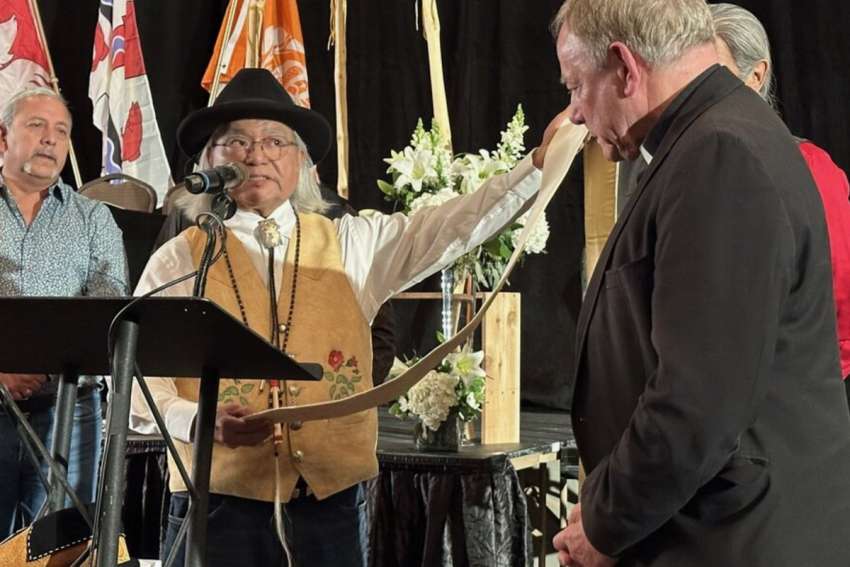Both leaders credited former Kamloops Chief Manny Jules and former Assembly of First Nations Chief Phil Fontaine for what Casmir said was “the seed of the idea that was planted” in 2021.
Casimir offered a “special, special thank you” to the two for drafting the initial Sacred Covenant, “and for the many, many hands that continue to shape it and nurture it to bring it to this signing.”
Miller and Kamloops Bishop Joseph Nguyen took part in the signing ceremony Easter Sunday. At the ceremony, Miller offered his appreciation to the two former chiefs, who became involved after reports in 2021 of missing children at the site of the former Kamloops Indian Residential School.
“They wanted to bridge the wide gap that had developed between First Nations and the Catholic Church,” Miller said. “They saw the understandable wave of grief unleashed because of the reports out of Kamloops. Together they made the hard decision to welcome Catholics into the healing journey that each nation was navigating.”
The Archbishop thanked them on behalf of the two dioceses for “their openness to the Catholic Church in this matter” and quoted Jules: “One cannot reconcile without the other.”
Casimir said for real reconciliation to happen, “We all need to come to the table with an open heart and open mind and an ability to listen. But also, to remember that we all must participate in that change and we need to share in that journey moving forward.”
After the reports of 2021, she said, “Our path to healing is now set out clearly in the Sacred Covenant to support the answers needed in the investigation into the missing children from the Kamloops Indian Residential School.”
In a statement, Church and First Nations leaders said the signing of the Sacred Covenant forges a new relationship between Church and Indigenous peoples in British Columbia, reflecting a mutual acknowledgment of past wrongs, particularly the Catholic Church’s role in the residential school system. It outlines a shared commitment to truth, reconciliation and the future and clarifies the Vatican “Doctrine of Discovery,” a series of political letters from the 1490s, by affirming subsequent formal Church teaching: the 1537 Papal Bull Sublimus Deus which clearly confirmed the equal dignity and rights of Indigenous people. The Archbishop said any Catholic explorer “who exploited Indigenous people in this region did so in direct violation of Church teaching.”
Although the former residential school is in the Diocese of Kamloops, the territory was part of the Archdiocese of Vancouver until 1945.
Miller also thanked Casimir, who “seized an opportunity for further healing.” She “has forthrightly and passionately articulated the need for the Catholic Church to be transparent, accountable and ready to listen and learn. We are here today as a sign of our willingness and our commitment to do just that.”
The covenant also outlines practical commitments, including honouring and memorializing residential school students, facilitating access to historical records and retaining scientific expertise to support efforts to uncover the truth and promote healing to “get the answers you deserve,” Miller said.
“We respect that you have so much work to do within your communities to comfort Elders and must decide prudently when and how to proceed. We stand ready to follow your lead.”
Casimir said investigations into the underground anomalies reported in 2021 are still at the “oral tellings, truth-telling” stage, with no excavation efforts started.
“We’re working with special technicians to look at that process moving forward,” she said, adding she is waiting for the final report from the federal government’s special interlocutor, Kim Murray, in June.


